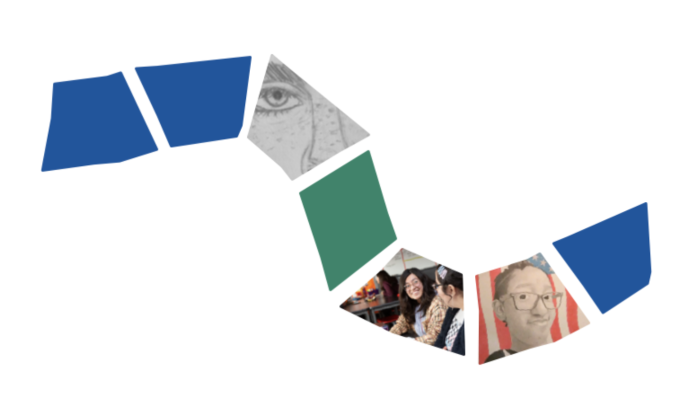Design Principles
The Design Principles translate insights from the Striving to Thriving research into a set of recommendations intended for use across a variety of organizations and functional roles.

Center young people
Young people are engaged as co-designers of policies and programs, rather than just participants, and adults serve as guides rather than gatekeepers.

Advance equity at an individual, systems, and community level
Programs, research and policies pursue equitable outcomes for individual communities of young people while also working to dismantle systemic barriers to a more equitable future.

Foster connections and build networks
Young people have opportunities to access and cultivate diverse professional networks and expand peer connections.

Illuminate and provide opportunities for meaningful exploration of career pathways
Young people learn about, explore and experience a diversity of career pathways, which enables them to reach their vision of a good life.
Take the Assessment
Resources and Opportunites
Design Principles in Action
The following descriptions are examples of how different types of organizations might enact the Design Principles emerging out of the Striving to Thriving research. After reviewing these hypothetical examples, you can reflect on your own organization’s progress in putting these principles into action by using the Assessment Tool.
-
School-Based Career Pathways Program Improves Student Engagement
Here is what it might look like to activate all four principles to support program design and youth experience.
Overview: A school-based program for high school students in a mid-sized Southern city improves student engagement by reflecting on their own biases, collaborating with students, and connecting students to opportunities to imagine their futures.
Problem: Staff at a school-based career pathways program planned a session where students in their program could give feedback on the program, including the tutoring services and monthly “career day” presentations featuring adults from a diversity of industries. Program staff learned that while students were interested in hearing about different careers, the students felt that the program offerings did not reflect themselves or their interests.
Solution: In light of student feedback, the program’s leadership and staff made changes to the design of programs in the following ways:
- The organization sought out different professionals who had the types of careers students were interested in by tapping their networks and connecting with the local chamber of commerce. (Illuminate Pathways, Foster Connections)
- The organization took particular care to bring in adults who were not only of similar racial and ethnic backgrounds to the students and who as a group had a similar gender breakdown, but also grew up with similar socioeconomic backgrounds. (Advance Equity)
- As the program proceeded, program staff also carved out ongoing opportunities for young people to develop relationships with peers, including a weekly hour-long session where young people met without adults in the room. (Foster Connections)
- Young people expressed gratitude for the opportunity to meet in a less structured, judgment-free space where they could talk openly about their interests and ideas for their futures while also learning about each other and building relationships with peers — some young people reported learning more about their peers in a couple of sessions than they had in being in the same classrooms with them for years. (Center Young People)
Impact:
- Belonging: On feedback surveys, more than 85 percent of students gave the program high marks, saying they felt like they belonged in the program and would recommend it to a friend. Students reported that they feel listened to by program staff and reported a sense of ownership over the program.
- Confidence and Connections: Of graduating students in the program, more than 90 percent report that they feel confident about how and where to seek out resources related to pursuing their career goals, and that they now know at least three peers or adults outside their families who can support them.
-
Here is what it might look like to activate the Center Young People and Advance Equity design principles to support research.
Overview: A longstanding research collaborative specializing in education outcomes develops a novel approach to equitably involving the young people they study in their research.
Problem: Collaborative Y conducts large scale surveys of young people in middle and high school and wanted to find a way to more deeply embed young people in the research process beyond being participants.
Solution: Collaborative Y changed its practices to Center Young People in research design and analysis. Specifically:
- They sought out students from middle and high schools in their region to serve as a youth advisory team.
- The youth advisory team helped determine the questions to be included on a new survey.
- Collaborative Y brought on interns from the local community college and trained them in survey analysis, which served the purpose of building young people’s capacity in this skill.
- The interns were of a similar background to the young people being studied and thus were able to provide unique insights that the adult research staff could not develop on their own.
- Collaborative Y established a feedback loop wherein young people could review findings and provide feedback before making the research public.
Impact: As a result of the interns and youth advisory team’s input, the research collaborative made several changes to how their organization operates in ways that Advance Equity.
- Research approach: Collaborative Y decided to always disaggregate data by race and/or ethnicity, where previously they had done it often but not for every study.
- Staff reflection: Collaborative Y took the opportunity to examine their own staff team. They reflected on how race and gender play a role in how they understood and made meaning of data.
- Talent pipeline: As a result of the reflection process, Collaborative Y sought to build out their research team to better reflect the population they study. They created a fellowship program to provide undergraduate students of color with the opportunity to experience research as a career pathway. These steps resulted in a broader, deeper bench of collaborators, both young and adult, from whose lenses young people’s experiences could be better seen and understood.
-
A Foundation Revises its Grantmaking Strategy With Young People’s Guidance
Here is what it might look like to activate all four design principles to support grantmaking.
Overview: A foundation focused on supporting postsecondary students involves young people in their grantmaking in order to better help them navigate their pathways.
Problem: Foundation Z works to increase the number of underrepresented young people who enter and successfully complete post secondary education and college, and are ready to enter high demand and growth careers. For the past 20 years the Foundation has invested in a strategy that supports college scholarships, on-campus peer mentoring programs and career counseling and guidance. Recently they completed a review of their investment strategy and found that college completion rates and students’ evaluation of their own career readiness were consistently lower than expected.
Solution: Foundation Z sought out advice and input from young people to better understand the impact of their grantmaking in their state.
- Foundation Z supported grantee organizations in their state to survey young people who participated in their programs. The survey was designed to learn more about young people’s experiences and the needs young people felt current programs did not meet. (Center Young People)
- In the survey young people report that having enough money for school is an important concern, but there are other non-financial barriers they encounter to remaining on track to graduate, especially for those students who were the first in their families to attend college. Young people also expressed an interest in getting connected to professional networks, career advisors, and internship opportunities, noting that they and their peers knew that such connections would be helpful but that they did not know where to find such support. (Center Young People, Foster Connections)
- The Foundation convened a group of peer funders working in workforce development and college completion in their state and shared the results of their youth survey and their evaluation. The group agreed to develop a funding collaborative that would leverage pooled funds to support programs and interventions aimed at filling the gaps young people identified in the survey. The funder collaborative set a collective goal aimed at increasing college completion rates and expanding access to high-quality career pathways for young people of color and first-generation college students. (Advance Equity, Illuminate Pathways)
- Most importantly, the funder collaborative decided that young people themselves would help to determine what grants would be made through the collaborative. The funder collaborative recruited and trained a youth advisory board from high school and post-secondary institutions across the state, to help oversee grantmaking. The majority of the board members were young people from historically marginalized communities and first generation college students. (Center Young People, Advance Equity)
- Members of the youth advisory board were paid for their service to the philanthropic organizations and also received internship and apprenticeship credits towards their post-secondary graduation requirements. (Advance Equity, Illuminate Pathways)
Impact:
Foundation Z’s funder collaborative has made the youth advisory board a permanent part of their grantmaking approach, and they are seeing some early indications of impact on college completion rates.
- Building Skills and Connections: Exposure to grantmaking has been powerful for young people. Feedback surveys from youth advisors track and increase in young people’s knowledge and skills related to the field of grantmaking. Every youth advisor reports an increase in the number of peers and adults in their professional network that they can rely on for support. (Foster Connections, Illuminate Pathways)
- Mutual Benefit: The youth advisory board has created mutual benefits. It has provided young people with a meaningful opportunity to guide the foundation’s grantmaking and change the way the foundation allocates grants. Working directly with young people has changed how the grantmakers see both their own work and the knowledge and value inherent in young people. (Center Young People)
- Improved Outcomes: After three years of the youth advisory team and two years of the funder collaborative, an evaluation study found that 85 percent of young people receiving support from this foundation reported that they were planning to stay enrolled at their college the next semester — an increase of 22 percent. (Illuminate Pathways)

Download the Design Principles here and share them with your colleagues.
How has the toolkit impacted your work?
We want to hear how you’re applying what you’ve learned from the Designing Pathways with Young People toolkit to your work. Send an email to [email protected].



